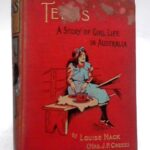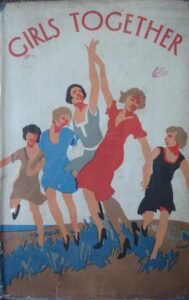by Whispering Gums and Bill Holloway
![]() A combined review of Louise Mack’s companion novels about young women, Girls together and Teens.
A combined review of Louise Mack’s companion novels about young women, Girls together and Teens.
____________________________________________________________________________________________________________________________
Last month we featured Louise Mack (1870-1935) in two posts – one comprising a short biography, and the other an example of her journalistic writing. She was active in the late nineteenth to early twentieth centuries, and wrote over 15 novels, as well as poetry and journalism in Australia and Europe.
Teens
 Born in Tasmania, Mack moved several times as a child, until the family eventually settled in Sydney in 1882. Schooled by her mother and a governess until then, in Sydney she started attending Sydney Girls’ High School, probably in 1884 when she was 13, a year after the school opened. This is relevant to today’s post as the first of the two books we are reviewing, Teens, begins with 13-year-old Lennie sitting and passing the entrance exam for School.
Born in Tasmania, Mack moved several times as a child, until the family eventually settled in Sydney in 1882. Schooled by her mother and a governess until then, in Sydney she started attending Sydney Girls’ High School, probably in 1884 when she was 13, a year after the school opened. This is relevant to today’s post as the first of the two books we are reviewing, Teens, begins with 13-year-old Lennie sitting and passing the entrance exam for School.
A large, brown, two-storey building, with a wide, wooden staircase, a verandah all round, and an asphalted playground, shaded with two huge Moreton Bay fig trees. This was the School.
After a lonely first few days she makes friend with 15 year old Mabel and this is the story of their year in ‘B’. The big girls studying to matriculate and get into university were in ‘A’.
Another little snippet of Mack’s biography is relevant to this post, because also at Sydney Girls’ High School, was Ethel Turner, the same age as Mack, and Ethel’s three years older sister, Lilian. The story goes that Ethel and Lilian established a school magazine (called Iris) when the school’s newspaper, Gazette, which was edited by Mack, rejected Ethel’s contributions. Despite this, Ethel and Louise were friends into their adult years. Anyhow, in Teens, Lennie and Mabel start a school newspaper. There is such demand for the initial hand-written version that they scrimp and save to get it printed, only to be trumped by the girls in ‘A’ with a much more impressive newspaper printed by one of their fathers. Bill suggests in his original post that as Lillian Turner was likely in ‘A’ when Mack was in ‘B’ this is a little bit of setting-the-record-straight.
Teens is a book for schoolgirls, what we would now call YA. The girls in the novel play with dolls, get into the usual school scrapes, have a crush on their (lady) teacher, sleep over, play tricks on Lennie’s older brother, and agonise over their school-work, Lennie fails to pay attention in Mathematics and ‘Euclid’, but comes top in English, French and History.
Despite this, however, the book has interest for today’s adult readers, for its lively account of middle-class life in 1880s Sydney, riding the trams and holidays in the Blue Mountains.
It was on the third storey that Lennie had her new bedroom. There was a little, irregular-shaped room up there, very narrow, but as long as the house was deep, that looked over other people’s yards at one end, and at the other, opened upon a stretch of suburb, ending in the sands of Botany Bay. From that window Lennie had one golden glimpse of the lazy, fair Pacific, and the calm blue waters of Botany Bay and its white sands; and nearer, the fresh, bright green of Chinamen’s gardens…
The younger girls had wonderful games of hookey .. The game was played in this way:—One girl was on one side, and any number on the other. The one girl chased the opposite side about the ground until she had caught one; then she and the caught one joined hands and chased again until they had caught another. Then these three joined hands and rushed to catch a fourth: and so on. And the fun was very high when there were forty girls all holding hands and chasing one about the playground…
“I’ve got the whole History of England to learn in three weeks, Mother, from William the Conqueror to Victoria; and the whole of the French Grammar, and the whole of the English Grammar; and two books of Euclid, and half of Peter the Great, and all the Physical Geography, and all the Arithmetic, and all the Geography of the whole world, to learn in three weeks.”“But you’ve had six months to learn them in.”“I know, Mother; but you see——”
Girls together
 Girls together is a sequel to Teens. It features protagonist Lennie (Elinor) Leighton, and again, her older friend Mabel.
Girls together is a sequel to Teens. It features protagonist Lennie (Elinor) Leighton, and again, her older friend Mabel.
The novel starts with this paragraph:
Square and solid as ever, stood the old brown school, with the fig-trees standing in its playground. The wooded staircase was as firm as even under the rush and onslaught of hurrying feet; the sturdy gate still bore with patience the cruel slammings of girls, big and little, rushing in late when the bell had finished ringing, or hastening homewards before half the school had left the classrooms.
It goes on to describe the chaos and disorganisation attending Lennie who is running late for her train home, and has, besides, lost her ticket. It starts, in fact, like a traditional school story. However, the book is not what it initially seemed. School is part of it, but the focus is 16-year-old Lennie at a point of transition in her life – and her relationship with her 18-year-old friend Mabel, who returns in the opening chapters from Paris and is training to be an artist. Lennie belongs to the tradition of some other famous sisters – like Judy in Ethel Turner’s Seven little Australians, Jo in Little women, and even, in a way, Elizabeth in Pride and prejudice. She’s impulsive more than sensible, but is loyal and generous of heart to those whom she loves. She lives with her parents (the Mother and the Doctor), her big brother Bert who is at University, and her little sisters, sensible Floss, gentle obedient Mary and the youngest, 11-year-old Brenda, who is observant, quick and a bit naughty. I’m sure you can recognise some of these “types”.
There is a marriage plot – but not for Lennie. This is more a coming-of-age book than a romance: it’s about Lennie’s transition from self-focused girlhood to adulthood and its associated more mature world-view. This, Mack handles nicely. Her characters may be recognisable types – but they are also individualised. Mack authentically captures how girls feel, and how they relate to each other. Here is Lennie meeting her friend Mabel after two years’ separation:
You see they merely hovered on the outskirts of all they meant to say, touching things lightly, with the shyness of their reunion still lingering around lips and eyes. But as the twilight deepened, and darkness came softly into the bedroom, laughs grew more and more frequent with them.
But, there are many writers who capture relationships and communication well. What makes this book particularly interesting to read for us, now is, as in Teens, the social history, the picture Mack paints of 1890s Sydney, including a reference to the Banking Crisis of 1893. The reference is brief, but it is used as a plot point in the trajectory of Lennie’s life.
More interesting, though, is the discussion of gender. Louise Mack was not an activist in the Australian suffrage movement but she was part of the “women-oriented culture” which was becoming increasingly visible from the 1890s. Gender issues, sometimes directly, sometimes indirectly, underpin much of what happens in Girls together. Indirectly, it’s there, for example, in an assumption that “girls” can go to university. Whether they should or shouldn’t isn’t even discussed. It’s just assumed that they can. Direct references, though, abound. Mabel’s art teacher in Paris tells her:
‘When you go back to Australia, Mees, you just take care you do not marry, for eef you marry you will never paint better than you do now.’
And the girls themselves frequently discuss gender issues, sometimes with Lennie’s brother Bert. There’s a discussion about ambition where Bert suggests that Mabel and Lennie talk about it constantly while men, he says, never do. Does this reflect women’s increasing awareness that they can have goals beyond the domestic? There’s a reference to Lennie’s mother’s anxiety about the potential for girls failing in their push for “public” careers, and, being a woman of her times, she “would have kept them back from success rather than let them face the chance of failure.” All this is told naturally, not melodramatically, giving a realistic sense of a normal family facing changing times. We see parents having their thoughts and concerns, but supporting their children, rather than opposing them.
Nonetheless, this is a book of the 1890s. So, when Lennie is told by Mabel’s art teacher – a character respected in the novel – that “It’s better to be a good woman than a great one, little girl … unless you can be both”, we wonder what Mack really saw as options for her heroine. And this we don’t really know, because the novel has an open ending. This may be because Mack planned to write more about the family – and she did write a third novel, Teens triumphant, in 1933 – but it may also reflect an awareness that girls’ lives aren’t complete at the age of 17 or so, and that Lennie still has a chance at greatness!
Finally, there are lovely descriptions of Sydney, but it is not overdone. There is lovely colour to the setting, but it is used sparingly to set the scene – and perhaps convey some attendant emotions:
The year was at September, when suddenly Summer came stepping down from her niche among the seasons, and ousted Spring before her time was well begun. The hot winds from the great inland plains of New South Wales blew down over the mountains to this city at the Harbour’s edge, and suddenly everyone woke from their winter cosiness, and furs and fires, and delightful nights, to find that the time for sleeping was over, and the restless nights and long, trying days of the Australian summer-time had come again, long before their time was due.
Girls together is an entertaining, refreshingly written story that draws on Mack’s own experiences and concerns. It also reflects the social consciousness for which the period is well-known and, as an urban novel, it offers an antidote to the “bush realism” school which was still prevalent for which the 1890s are best known.
Louise Mack, Teens: A Story of Australian School Girls, first pub. 1897. Angus & Robertson (paperback) 2016. PDF version from University of Sydney Library.
Louise Mack, Girls Together, first pub. 1898. London, The Pilgrim Press [n.d]
_______________________________________________________________________________________
Whispering Gums, aka Sue T, majored in English Literature, before completing her Graduate Diploma in Librarianship, but she spent the majority of her career as an audio-visual archivist. Taking early retirement, she engaged actively in Wikipedia, writing and editing articles about Australian women writers, before turning to litblogging in 2009. Australian women writers have been her main reading interest since the 1980s.





Thanks, Sue and Bill, for another fascinating piece on Mack’s life and work.
Thanks Elizabeth. She was an energetic character.